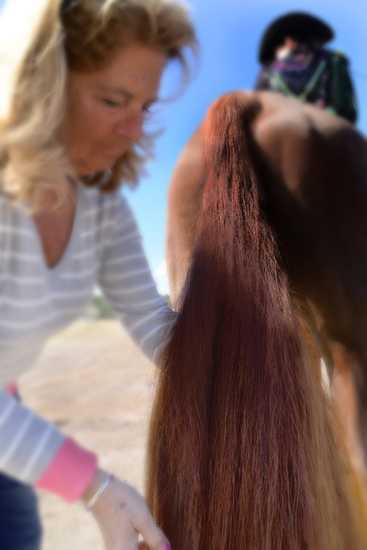 Tail extensions made their first appearance on the show circuit about 25 years ago when they became legal in some breed associations. Today, hair to hair tail extensions are comonplace in almost all disciplines across the stock horse breeds with the exception of the ranch horse events where they are prohibited.
Tail extensions made their first appearance on the show circuit about 25 years ago when they became legal in some breed associations. Today, hair to hair tail extensions are comonplace in almost all disciplines across the stock horse breeds with the exception of the ranch horse events where they are prohibited.
Barb Delf of Blue Grass, Iowa who has been in the tail extension business since 1999, makes sure all her custom tail products are 100 percent horse hair, as are the loops and ties in order to comply with all breeds that allow tail extensions. In addition, her weighted tails also follow these rules.
“Most breed associations that allow tail extensions stipulate that they must be 100 percent horse hair. Attachment rules vary with the different breed associations- some have detailed rules regarding hair to hair attachment, others do not,” she said. “Braided horse hair loops or braided horse hair ties fulfill the requirement for hair to hair attachment. The breed associations that allow tail extensions allow weighted tail extensions. Be sure and check with your breed association regarding their rules about tail extension use.”
Rules regarding tail extension use can be found among your breed’s handbook like as for instance per the 2016 American Quarter Horse Association Handbook reads:
VIO 320.3 tails lengthened by hair to hair attachment only with no attachments of any kind to the tailbone. The use of weighted tails is legal.
As an avid breeder and showman, Delf explained the many advantages to using a tail extension including giving the horse a more balanced look that is pleasing to the judge’s eye.
“A good looking tail of proper length balances the long clean lines of the neck and head. This makes for a pleasing picture to the judge,” she said. “Tail extensions can also help conceal conformation faults such as a weak hock set or a less than perfect gait. If your horse has a poor tail set, or uses their tail, you may want to consider a weighted tail extension. Weighted tails help flatten tail carriage and will quiet the motion of a busy tail. Again, this will make a prettier picture for the judges.”
Kathy Williams of Mendon, Ohio, has found her adjustable and removable weighted tails are by far her company, Kathy’s Tails, most popular selling item. She says 98 percent of her clients prefer these particular tails.
 “We offer a variety of styles of tails but our most popular by far is the double loop adjustable, removable weighted tail,” she said. “If these tails are put in correctly, you are not going to see them and should have a natural look. Every tail makers’ nightmare is a tail that is tied in wrong.”
“We offer a variety of styles of tails but our most popular by far is the double loop adjustable, removable weighted tail,” she said. “If these tails are put in correctly, you are not going to see them and should have a natural look. Every tail makers’ nightmare is a tail that is tied in wrong.”
Tails that are not matched well to the horse or are incorrectly attached can instead be a hindrance to the competitor. So, it is absolutely imperative that the tail is attached correctly.
“Tail extension disadvantages include tail extensions that don’t match the horse’s tail color, are not braided in well, or don’t fit with the horse’s discipline,” Delf said. ” Any of these issues will draw the judge’s attention in a negative manner and will not make the impression you want to achieve in the show pen.”
A common drawback that AQHA and NSBA judge and professional horse trainer, Chris Jones of Reelsville, Indiana, sees with tail extensions are those that are hung at the wrong height.
“If the tail is too low, you are subject to get it pulled out and stepped on when you are backing your horse and if it is too high then it doesn’t have the right look either,” he said. “I like the tail to be even with the middle of the horse’s hind fetlocks.”
When judging Jones explains a poorly hung tail can deter from the overall presentation.
“A tail that gets caught between the horse’s back legs either on a Hunter Under Saddle horse trotting or on a Western Pleasure horse loping can be very distracting,” he said. “While it would not totally influence my opinion of the horse, it does deter from what the horse actually moves like.”
Williams has found that if the tail extensions are put in correctly they will rarely go between the horse’s back legs. In some cases like with a horse who travels very deep in his hock, this scenario is harder to avoid.
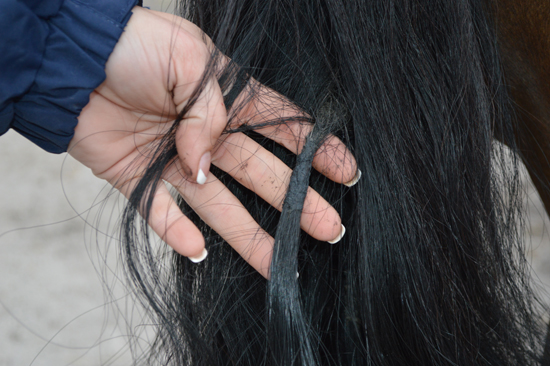 “I suggest not making the tail too heavy at the bottom and actually thinning the tail at the bottom really helps in avoiding your tail extension to go up between your horse’s hind legs,” she said. “We do offer both blunt and taper ended tail extensions.”
“I suggest not making the tail too heavy at the bottom and actually thinning the tail at the bottom really helps in avoiding your tail extension to go up between your horse’s hind legs,” she said. “We do offer both blunt and taper ended tail extensions.”
Delf also offers both types of tail extension bottoms and says the decision to show with a blunt or tapered bottom tail mostly depends on the discipline in which a competitor is showing.
“The decision to show with a blunt or tapered tail extension is based somewhat on the age of the horse and the discipline they show in,” she said. “Right now, the trend is for tail extensions with blunt bottoms especially with the rail and all-around horses.
Reiners, Yearling Longe Line and Hunter/Jumper horses normally show with a tapered tail but we are seeing blunt end tail extensions in these classes as well. It really comes down to a matter of personal preference- it’s whatever look you like.”
There are many different effective styles of how to tie a tail extension in. Williams recommends the three braid method where three strands of the horse’s real hair are braided into the extension.
“I prefer the braided method because especially with the weighted tails which are heavy the hair is less likely to shift or slide down with a tight braid,” she explained.
Delf agrees.
“We offer three styles of attachment options braided horse ties, braided horse tie loops and tube attachment. The loops and ties attachments are similar; they braid into the horse’s tail hair keeping the top of the extension snug against the tail bone. The tube attachment braids in at the bottom of the tail bone with a braided portion of the horse’s tail hair inserted through the vertical tube in the top of the tail extension,” she said. “The secret to a secure, well attached tail extension is braiding it in with a tight braid and snug against the tail bone. They are only going to stay in well if they are put in well! Braiding them in on the topside of the tail bone and utilizing stabilizer braids to lock them in place will ensure the tail extension stays put and looks good.”
 When tying in a tail that will have a the tail bone braided as seen Hunter Under Saddle and over fence classes, Williams advises first tying in the extension as you normally would then braiding the tail bone over it.
When tying in a tail that will have a the tail bone braided as seen Hunter Under Saddle and over fence classes, Williams advises first tying in the extension as you normally would then braiding the tail bone over it.
She also strongly recommends picking a tail color that would be the closest to your horse’s natural color tail. Both Kathy’s Tails and Custom Tails can be seen at various shows throughout the country during the year and often will match tails right there or they will use photos of the tails to try to match on internet orders.
“Look at your horse’s natural color tail and try to match it the best you can,” Williams says. “I do not recommend adding color in tails that would not naturally be there. Don’t try to make the tail color something it’s not.”
As a trainer, Jones picks tails that are easy to put in and prefers the weighted tails on his performance horses which help keep the horse’s tail laid down. He has had great success with Kathy’s Tails in finding the right tail for each horse.
“If we aren’t sure on color, Kathy Williams will help us decide on the right blend and custom make us a tail,” he said. “With the futurity horses, I recommend practicing in the tails so that your horse is good and comfortable with them before you show. It’s also important to look at the tail in the horse and decide if it’s the right color and size and use whatever works best for that particular horse.”
The care of your tail extension is crucial in it having a long life. Both Delf and Williams have similar pricing on tails. Custom Tails range from $90 to $640 with the average tail costing $200. Kathy’s Tails start at $200 on the darker colors and go up from there depending on the color, weight, length and amount of hair making up the extension.
“The more common tail colors, the blacks, sorrels and chestnuts are the least expensive whereas the gray, flaxen and white shades are harder to get, making the tail hair more expensive,” Delf explained.
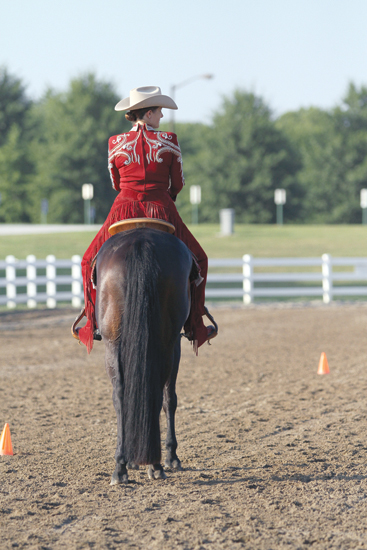 According to Williams, it is best to wash your horse’s tail every time you show in a bucket like an old pair of socks. She does not recommend combing while the tail is still wet.
According to Williams, it is best to wash your horse’s tail every time you show in a bucket like an old pair of socks. She does not recommend combing while the tail is still wet.
“A dirty tail extension is not going to look natural. So keep your tail extensions clean,” she advised. “I like to keep them in a nylon sock which allow the top of the tail to breathe. The tops will rot if they are not allowed to fully dry.” Delf also recommends keeping tail extensions clean and says if they are properly taken care of you can expect eight to 10 years of use out of them. “Since tail extensions are horse hair, they should be cared for just like your horse’s own tail,” she said. “Wash them in a quality equine shampoo after every day of completion, condition as needed and store them in a tail bag. Tail bag storage will prevent the tail hair from catching and tangling on hooks, snaps, etc.”
In addition, Delf suggests washing your tail extension in a liquid dish soap like Dawn, Ivory or Palmolive every couple of months to prevent product build up that comes from sweat, fly spray, arena dust, finishing sprays, etc that shampoo can’t remove.
“Keep your use of hair care products to a minimum-with tail extension hair, less is more, which will help prevent product build up. We don’t recommend leaving tail extensions in overnight. They can easily get caught on a bucket or hook or get stepped on,” she said. “Our preferred horse show regime is to wash the tail extension after the show, hang it to dry and then apply a small amount of detangler to the extension. Work the detangler through the tail extension and then brush it out so the tail extension hair is silky and full.”
Besides the one-piece tail extensions, Terry’s Tails owned by Terry Irwin of Lewisburg, Pennsylvania specializes in making tie-in tail pieces that are generally comprised of four pieces per pound of hair.
“I will make up a tail anyway the customer wants but I custom make the four piece tails because I think they are a better way to go for a more natural look than one piece tie-in tail extensions,” she said.
The tail pieces are real horse hair that are glued at the top with vet wrap over the glue in a basic loop. Terry said the vet wrap makes the pieces more flexible to put in and her customers have found them to be longer lasting.
“I feel the tail pieces are more versatile because you can adjust different pieces of different coloring in as needed, which is popular among my Paint horse customers. You can also adjust the length and the amount of hair you want in the tail as it applies to the horse,” she said. ” I also find the pieces to be more comfortable for the horse because they move more freely in the tail and do not split from the real tail when the horse swishes their tail.”
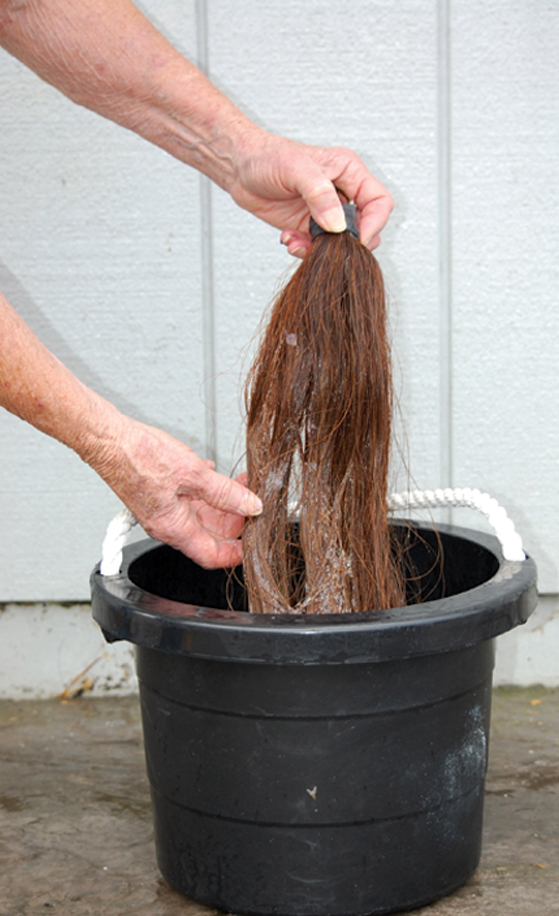 Irwin also now makes her tail pieces weighted for customers wanting to lay a horse’s tail down some while still obtaining a more natural look.
Irwin also now makes her tail pieces weighted for customers wanting to lay a horse’s tail down some while still obtaining a more natural look.
“My customers have their own techniques on tying the pieces in but for my first time buyers I tell them to split a piece of hair pulling the hair through the loop and rubber banding around the back or some of my customers prefer to braid the hair in,” she said. ” I recommend taking care of them similar to a regular tail. Keep them clean and try not getting them too wet. I also tell customers to keep them protected by storing in a tail bag.”
Terry’s tail pieces begin at $130 and range upward to $300 based on the amount and color of the hair as the lighter color hair is always more expensive.
“I have had many of the same customers for years and if taken care of properly the pieces can last for several years,” she said. “If the vet wrap begins to break down I do repairs on them. They work really good and although I do make any kind of extension a customer requests once they try the tail pieces they generally do not go back.”
Beyond the tie-in tail extensions, another option is to glue in the horse hair. Beth Johnson-Dunlap of Newnan, Georgia first started gluing in tails about five years ago when she was frustrated with the way a tie-in tail looked on a 2-year-old she had who had his tail chewed off. She had seen the glue-in tails before and decided to give it a try and was so pleased with her results that she began practicing and teaching herself how to put them in efficiently and effectively.
Her Pony Tails Custom Equine now has a client base that consists of many of the country’s top horsemen for whom she was worked on many World and Congress Champions as well as other breeds like Thoroughbreds and Morgans.
“Many of the horses that I work on are Halter horses,” she said. “With the glue-in tails you use the color, thickness and length of the tail to highlight your horse’s conformational attributes. For example, I would recommend using a fuller tail on a horse that doesn’t have as much muscle behind and less tail in thickness on a horse that has a big gaskin because you would not want the tail to cover that. Also a horse that has a bad hock set would be a horse that would look better with more tail.”
When working on a horse, Johnson-Dunlap first looks at them from the profile view and decides if that tail matches the horse well.
“I like to use a naturally tapered tail,” she said. ” I think you really need to consider the age of the horse and what is an appropriate length for that horse.”
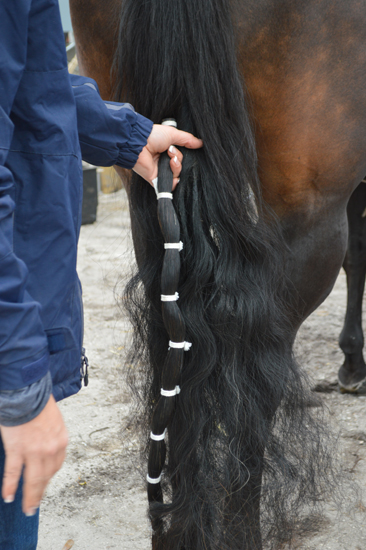 Johnson-Dunlap keeps a good selection of hair on hand and matches the color based on the horse’s hair color from the center of the tail.
Johnson-Dunlap keeps a good selection of hair on hand and matches the color based on the horse’s hair color from the center of the tail.
“With a sorrel tail I will often use a lighter color if the goal is to highlight the horse’s attributes around the tail area like a really good hock set or a long hip as the lighter color will naturally draw your eye,” she said. “I would use a darker color sorrel if the opposite is true and you do not want to draw attention to this area.”
In weanling Halter horses, Johnson-Dunlap has sometimes used mane hair so that they look more natural.
“Weanlings have shorter, immature hair. Some are very big and growthy and just look a little more mature with a little extra tail,” she explained. “I have also worked on Yearling Longe Liners and Thoroughbred yearlings for sales who too can be in an awkward stage and just need a some extra tail but not too much where they do not look age appropriate.”
Starting with just horse hair, salon quality hair glue and a hair dryer, Johnson-Dunlap applies hair from the center of a clean but non-conditioned tail. She applies the hair in small sections as needed setting each glued in piece with heat.
“You must be very patient and be very detail oriented to do a good job,” she said. “You have to take your time especially on special cases like a chewed off tail which I actually layer the pieces in to give it the most natural look.”
For overall care, Johnson-Dunlap recommends leaving the tails alone as much as possible and not applying oil based products like hair conditioners to the tail especially around the glue as it will cause it to break down. On the contrary, baby powder is good to put on the glue to help to keep it from breaking up enabling the tail extensions to last longer.
“I do not recommend washing them a lot or using a lot of products in them,” she said. “Sometimes if the tail is long and there is a problem with the horse stepping on it, I would put it up in a sock or figure eight knots with pieces of vet wrap around them too just keep them up.”
During the off season, Johnson-Dunlap does recommend taking the glue out as the horse’s real tail can get ripped out along with the fake hair if it gets caught up on something.
“I use an oil based product to take the glue out like WD 40, Pepi or Rose Oil,” she said.
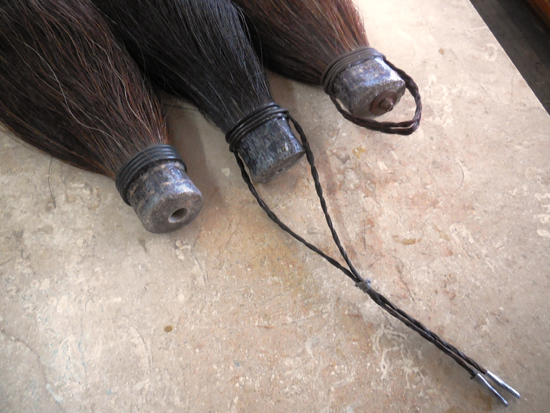 The biggest disadvantages Johnson-Dunlap hears about with the glue-in tails is that they are costly for the amount of time they last versus the tie-in extensions. She starts at $350 per tail and goes up from there based on the amount and color of the hair.
The biggest disadvantages Johnson-Dunlap hears about with the glue-in tails is that they are costly for the amount of time they last versus the tie-in extensions. She starts at $350 per tail and goes up from there based on the amount and color of the hair.
“Many of my clients look at them as an investment for the bigger shows,” she said. “They can last up to three months or more depending on the horse and how they keep a tail. I often do tails at the AQHA Youth World Show in August that if kept well will only need a refresh to make through the Congress and AQHA World Show in the Fall. It totally depends on your circumstances like the events you show in, your horse’s tail and what looks the very best.”
Longtime AQHA Professional Horseman and judge, Jon Barry of Advance, Missouri agrees.
“When showing a horse in Yearling Longe Line classes, you do not want the tail to be any longer than a tail would naturally look on a baby of that age,” he advised.
Barry does not like tails that look dead or unnatural but rather a tail that just lies flat. He explains that weighted tails can be a good solution however sometimes a tail that is too heavy on a yearling will not always look right.
“It just depends on the horse as to what looks best,” he said. “I do like a tail that is tapered on the end for the yearlings because it does look more natural. You generally see the blunt ended tails on the older horses. I think whatever discipline you show in, the key is to just make it look as natural as possible.”


You must be logged in to post a comment Login